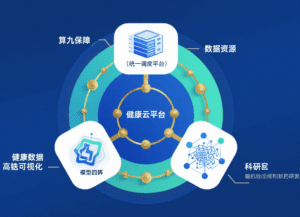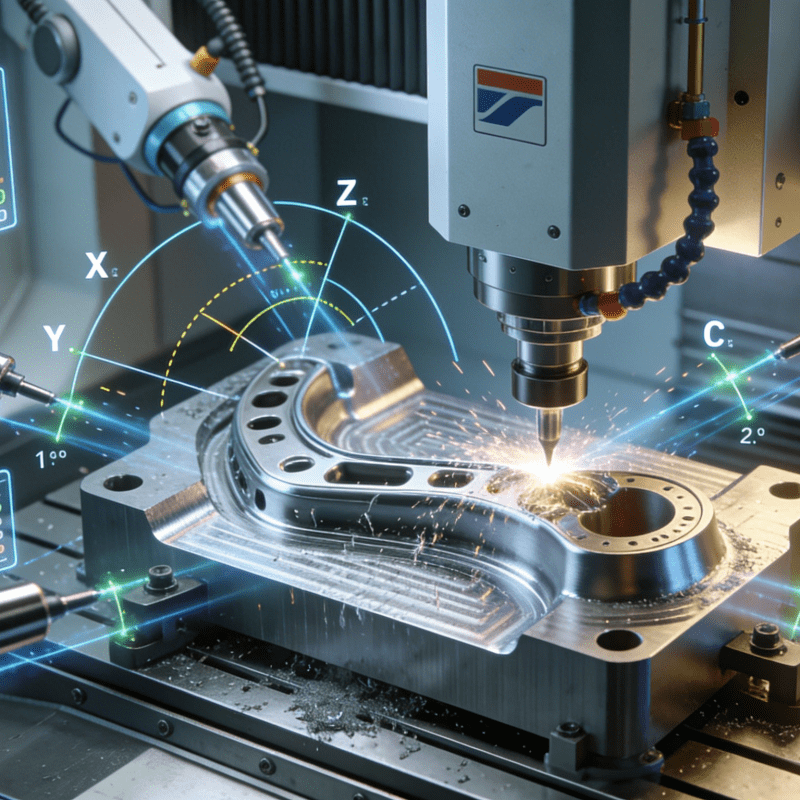
Core Development Targets by 2027
By 2027, a national artificial intelligence medical industry application base will be fully established, a cluster of medical intelligent agents with the Anzhen’er medical large model as the core will be built, more than 50 high-quality industry corpora and disease-specific/specialized models will be developed, more than 10 core medical AI technologies will be breakthrough and transformed, and more than 100 key healthcare scenarios will be constructed covering 6 major fields including the public, doctors, hospitals, scientific research, industry, and government.
- Purpose of the Action Plan
Action Plan for Accelerating the High-Quality Development of “Artificial Intelligence + Healthcare” in Zhejiang Province (2025-2027)
To implement the strategic deployment of the Party Central Committee and the State Council on the “Artificial Intelligence +” action, as well as the decisions and arrangements of the Provincial Party Committee and the Provincial Government on deepening the construction of “Digital Zhejiang” and promoting the high-quality development of artificial intelligence, and to accelerate the development and application of medical artificial intelligence, this action plan is formulated.
- Development Goals
Led by the high-standard construction of a national artificial intelligence medical industry application base, based in Zhejiang and radiating across the country, adhering to the principles of government leadership, multi-party participation, intensive coordination, and safe and controllable development, we will promote artificial intelligence to fully empower the health industry and the life and health sector, and build a highland for pilot verification, industry application, and industrial ecology of “Artificial Intelligence + Healthcare”.
- Specific Development Goals by 2027
By 2027, we will fully establish a national artificial intelligence medical industry application base, build a cluster of medical intelligent agents with the Anzhen’er medical large model as the core, develop more than 50 high-quality industry corpora and disease-specific/specialized models, break through and transform more than 10 core medical AI technologies, construct more than 100 key healthcare scenarios covering 6 major fields including the public, doctors, hospitals, scientific research, industry, and government, cultivate a number of innovative medical artificial intelligence enterprises and interdisciplinary talents, build an innovation chain, service chain, and industrial chain of medical artificial intelligence from infrastructure guarantee, key technology research to innovative application demonstration, and form a government-enterprise-research-medical collaborative network radiating the whole country.
Constructing a Support System
mproving Computing Power Guarantee
Improving computing power guarantee. Relying on Health Cloud and other platforms, accelerate the construction of a diversified computing power supply system and a unified scheduling platform that meet the characteristics of the health industry, forming a computing power support capability with a unified architecture, intensive sharing, and full-stack empowerment. Reduce the computing power usage costs of medical and health institutions through means such as computing power vouchers. (Responsible units: Provincial Development and Reform Commission, Provincial Data Bureau, Provincial Health Commission)
- Aggregating Data Resources
Aggregating data resources. Formulate and improve systems for data security management and utilization in the health field, standardize the collection, processing, circulation, and utilization of health medical data. Establish a health medical data standard system. Promote the upgrading and expansion of the Health Data High-Speed Rail, strengthen the aggregation of multi-subject and multi-modal data. Build a trusted data space for the health industry, develop data governance tools and intelligent engines. Construct a provincial medical and biological information database, and jointly build and share high-quality industry datasets and corpora. (Responsible units: Provincial Health Commission, Provincial Data Bureau, Provincial Medical Insurance Bureau, Provincial Drug Administration, Provincial Center for Disease Control, Provincial Administration of Traditional Chinese Medicine)
- Building a Model Matrix
Building a model matrix. Create multi-modal medical industry large models, build a fully autonomous AI research and development framework, and form common model service capabilities. Develop a number of disease-specific/specialized models and medical intelligent agents covering medical services, health management, public health, drug and device research and development, and industry governance. (Responsible units: Provincial Health Commission, Provincial Cyberspace Affairs Commission, Provincial Medical Insurance Bureau, Provincial Drug Administration, Provincial Center for Disease Control, Provincial Administration of Traditional Chinese Medicine)
Strengthening Scientific and Technological Research
Strengthening scientific and technological research. Deploy and implement major science and technology projects focusing on artificial intelligence data and applications, brain-computer interfaces, new drug creation, etc., and strengthen scientific research layout in interdisciplinary fields of multi-modal artificial intelligence, embodied intelligence with medicine and pharmacy. Encourage research institutions to strengthen interdisciplinary cooperation in medical artificial intelligence and form a number of globally influential scientific research achievements. (Responsible units: Provincial Science and Technology Department, Provincial Health Commission, Provincial Education Department)
Building a Sharing Platform
Constructing a Data Annotation Platform
Constructing a data annotation platform. Formulate standards for annotating multi-modal health medical data such as medical texts, tables, images, audio, and video. Accelerate the research and development of data annotation tools such as intelligent annotation review, quality evaluation, and expert annotation based on medical thinking chains. Establish a mechanism and information platform for intelligent annotation of health medical data through joint construction and sharing among clinicians, information experts, medical institutions, and technology enterprises. (Responsible units: Provincial Health Commission, Provincial Data Bureau)
Building an Evaluation and Verification Platform
Building an evaluation and verification platform. Construct an authoritative test dataset for medical artificial intelligence, establish an evaluation and verification standard system including algorithm performance evaluation, service capability maturity assessment, safety and ethical evaluation. Build a medical artificial intelligence evaluation and verification platform to carry out testing, evaluation, and verification services focusing on specialized disease models, medical intelligent agents, intelligent medical device products, etc. (Responsible units: Provincial Health Commission, Provincial Data Bureau, Provincial Drug Administration)
Building an Achievement Transformation Platform
Building an achievement transformation platform. Establish a medical artificial intelligence product supermarket to realize unified management and online circulation of knowledge, tools, and application components. Build a professional technology market to provide services such as seed fund support, market demand assessment, and business model design. Promote the market-oriented application of key research products of leading enterprises in the fields of artificial intelligence and healthcare. For example, in the production of intelligent medical devices, the thermometer visual labeling machine integrated with AI vision technology can automatically match the thermometer range with label information through image recognition to achieve high-speed and accurate labeling. Its technical achievements have been transformed through the platform and implemented in many medical device enterprises, effectively improving the standardized production efficiency of temperature measurement equipment in primary medical institutions. (Responsible units: Provincial Health Commission, Provincial Development and Reform Commission, Provincial Economic and Information Technology Department, Provincial Science and Technology Department, Provincial Medical Insurance Bureau, Provincial Drug Administration)
Accelerating Industry Application
Promoting AI Empowerment in Public Health
Promoting artificial intelligence to empower public health. Iteratively promote the Digital Health Person · Anzhen’er, build a cluster of personalized intelligent agent services covering the entire medical treatment process, and popularize “digital doctors that everyone owns and accompanies for life”. Promote intelligent wearable devices and embodied intelligence applications, explore the application of artificial intelligence in providing personalized health services for key groups such as the elderly, pregnant women, and infants. (Responsible units: Provincial Health Commission, Provincial Data Bureau, Provincial Center for Disease Control, Provincial Medical Insurance Bureau)
Promoting AI Empowerment in Clinical Medicine
Promoting artificial intelligence to empower clinical medicine. Focusing on the clinical diagnosis and treatment of common diseases, chronic diseases, and difficult diseases, accelerate the research and application of artificial intelligence technology, with emphasis on optimizing and clinically verifying auxiliary diagnosis algorithms in fields such as imaging, pathology, electrocardiogram, and endoscopy. Build an intelligent clinical decision support system for multi-disciplinary collaboration. Promote the application of intelligent medical robots in scenarios such as surgery, rehabilitation, and nursing. Support medical artificial intelligence products with high maturity, strong universality, and good safety to be prioritized for promotion and application in primary medical and health institutions. (Responsible units: Provincial Health Commission, Provincial Medical Insurance Bureau, Provincial Drug Administration)
Promoting AI Empowerment in Scientific Research and Teaching
Promoting artificial intelligence to empower scientific research and teaching. Build knowledge mining intelligent agents, construct research tools such as knowledge bases and knowledge graphs integrating multi-modal medical data and medical knowledge. Explore human-machine collaborative clinical research innovation systems. Based on technologies such as virtual reality, augmented reality, and mixed reality, develop personalized medical virtual tutors for auxiliary learning, and create medical simulation teaching and experimental environments. (Responsible units: Provincial Health Commission, Provincial Science and Technology Department, Provincial Education Department)
Promoting AI Empowerment in Traditional Chinese Medicine (TCM) Development
Promoting artificial intelligence to empower the development of traditional Chinese medicine (TCM). Improve the TCM digital standard system, build TCM specialized disease databases and classic medical case databases, and carry out intelligent auxiliary diagnosis and treatment for TCM clinical practice. Develop intelligent devices such as intelligent terminals for TCM four diagnostic methods, TCM rehabilitation, and intelligent service robots. Explore the digital inheritance of renowned veteran TCM doctors and intelligent grading technology for TCM decoction pieces. Promote the application of artificial intelligence in innovative research and development and quality evaluation of TCM preparations. (Responsible units: Provincial Administration of Traditional Chinese Medicine, Provincial Health Commission, Provincial Medical Insurance Bureau, Provincial Drug Administration, Provincial Science and Technology Department)
- Promoting AI Empowerment in Public Health
Promoting artificial intelligence to empower public health. Construct a closed-loop system for intelligent monitoring and early warning of infectious diseases based on real-time integration of multi-source data and adaptive models. Accelerate the intelligent application in fields such as epidemiological investigation, full-cycle management of tumor “prevention, screening, diagnosis, treatment, and rehabilitation”, and immunization planning, and promote the “electronic vaccination certificate” for the entire life cycle of individuals. Innovate methods for health supervision and law enforcement, promote off-site supervision, and improve the efficiency of supervision and law enforcement. (Responsible units: Provincial Center for Disease Control, Provincial Health Commission, Provincial Medical Insurance Bureau)
- Promoting AI Empowerment in Future Hospitals
Promoting artificial intelligence to empower future hospitals. Focusing on seven innovative fields of future hospitals, including new infrastructure, new medical care, new services, new management, new research, new environment, and new ecology, promote the comprehensive empowerment of emerging technologies such as artificial intelligence in improving diagnosis and treatment technologies, enhancing service experience, increasing efficiency in hospital management, and collaborating in clinical research, and build future hospitals with everything connected, panoramic intelligence, and digital twins. (Responsible unit: Provincial Health Commission)
Promoting AI Empowerment in Medical Insurance Management
Promoting artificial intelligence to empower medical insurance management. Build intelligent medical insurance monitoring and supervision modules, develop multi-scenario early warning models using artificial intelligence technology, and realize intelligent, full-coverage, and penetrating anti-fraud supervision of medical insurance. Innovate medical insurance service models, build an “instant inquiry and instant handling” intelligent agent for medical insurance, and construct a full-process intelligent service chain. Connect medical insurance and commercial insurance data to promote the development of “dual platforms and one channel” for medical insurance and commercial insurance. (Responsible units: Provincial Medical Insurance Bureau, Provincial Health Commission)
Promoting AI Empowerment in Drug and Device R&D
Promoting artificial intelligence to empower drug and device research and development. Promote the integration of artificial intelligence into the entire process of innovative drug and new-generation intelligent medical device research and development, accelerate its application in complex fields such as disease mechanism exploration, drug target discovery, and drug molecule design, and speed up new drug research and development and clinical trial progress. Explore the construction of an intelligent, precise, and compatible medical internet of things system. Develop innovative applications of brain-computer interfaces in scenarios such as medical treatment, rehabilitation, and health intervention. (Responsible units: Provincial Health Commission, Provincial Economic and Information Technology Department, Provincial Drug Administration, Provincial Science and Technology Department)
- Cultivating Industrial Ecology
Promoting Collaborative Development of the Industrial Chain
Promoting the collaborative development of the industrial chain. Support enterprises, research institutes, etc., to take the lead in establishing innovation consortia in fields such as artificial intelligence and drug/device creation, and brain-computer interfaces. Encourage the integrated development of the biomedical industry and the artificial intelligence industry, and cultivate and build a number of provincial-level future industry pilot zones in fields related to artificial intelligence and healthcare. Focus on the research and development of technologies such as artificial intelligence chips and intelligent sensors, and carry out applications in future industries such as cell and gene therapy, brain-computer interfaces, synthetic biology, and surgical robots. (Responsible units: Provincial Economic and Information Technology Department, Provincial Science and Technology Department, Provincial Development and Reform Commission, Provincial Health Commission, Provincial Drug Administration)
Strengthening Enterprise Incubation and Cultivation
Strengthening enterprise incubation and cultivation. Cultivate and expand the “Artificial Intelligence + Healthcare” enterprise echelon, support high-quality enterprises in related fields to apply for Eagle Enterprises, “Single Champion” enterprises, national specialized, sophisticated, distinctive, and novel “Little Giant” enterprises, and provincial “Invisible Champion” enterprises. Support localities to attract branches or research and development centers of domestic leading intelligent computing chip, data service provider, and general large model research and development enterprises in the healthcare-related fields. (Responsible units: Provincial Economic and Information Technology Department, Provincial Development and Reform Commission, Provincial Science and Technology Department, Provincial Health Commission, Provincial Drug Administration)
Supporting Industry Exchanges and Cooperation
Supporting industry exchanges and cooperation. Improve the “conference, competition, exhibition” exchange platform for medical artificial intelligence. Open up diversified international exchange and cooperation channels, lead or participate in the formulation and revision of international medical artificial intelligence standards. Encourage “Artificial Intelligence + Healthcare” enterprises to expand overseas. (Responsible units: Provincial Health Commission, Provincial Economic and Information Technology Department, Provincial Market Supervision Bureau, Provincial Department of Commerce, Provincial Drug Administration)
Guarantee Measures Strengthening Top-Level Design
Strengthening top-level design. Establish a unified planning, unified standard, and unified management mechanism for the innovative development of medical artificial intelligence and a public service platform in the province, and coordinate the construction and application of computing power, data, models, and scenarios in the health field. Public medical and health institutions at all levels shall strictly follow the principle of “full statistics and joint construction and sharing”, make full use of public platforms, open-source communities, etc., to carry out the construction and application of medical artificial intelligence scenarios in an orderly manner, avoiding small, scattered, and low-level duplication.
Strengthening Departmental Collaboration
Strengthening departmental collaboration. Focus on key tasks and links, strengthen the collaborative linkage among multiple departments such as health, development, economic and information technology, science and technology, drug supervision, and medical insurance, establish a normalized communication mechanism, and form a policy synergy. Deepen and promote the “research and review linkage” mechanism for intelligent medical devices, and optimize the approval process. Expand the scope of application of medical service charging policies, and accelerate the compatibility of artificial intelligence technology applications. Strengthen industry-university-research-application collaboration to accelerate technology transformation and scenario innovation.
Strengthening Financial Support
Strengthening financial support. Coordinate various funds such as central budgetary funds and ultra-long-term special national bonds, and guide social capital and industrial funds to support the research and development and application of medical artificial intelligence. Support medical institutions to increase investment in artificial intelligence research and development and application, and strengthen fund performance management. Build a industry-finance docking channel and optimize the whole-cycle financial services.
Strengthening Talent Introduction and Cultivation
Strengthening talent introduction and cultivation. Unusually introduce and cultivate expert teams in the field of medical artificial intelligence, build a health talent database, and accurately match talent needs with achievements. Relying on the National Medical High-Level Talent Training Base, join hands with top domestic research institutions such as the Chinese Academy of Medical Sciences to establish and improve a training system, innovate training models, and build an international interdisciplinary talent team.
Strengthening Safety Guarantees
Strengthening safety guarantees. Strengthen data privacy protection, improve the hierarchical protection and full-cycle governance system for healthcare data. Improve dynamic supervision and safety assessment mechanisms. Strengthen research on ethical and safety norms for medical artificial intelligence, adhere to “people-oriented and intelligent for good”, and ensure compliant and safe use.
LMS drawer slide fully automatic assembly machine
Artificial intelligence LMS drawer slide fully automatic assembly robot




















